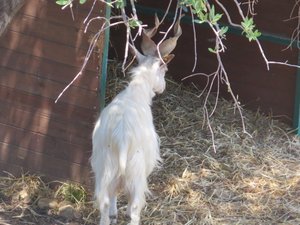Advertisement

 Capra Girgentana
Capra Girgentana
This breed is named after the town of Girgenti (modern-day Agrigento). Its long, spiraling horns, reaching up to 70 centimeters on the males, make it unmistakable. With its horns and white coat, it resembles wild Asian goats, and its origins, according to some, can be traced back to the goats of Tibet. The breed was probably brought to Sicily by the Arabs, who invaded in 827. From Mazara, they spread around the island, travelling with their animals, and the goats became established in the southwest of Sicily. Their milk is renowned for its excellent balance between fat and protein.We took a train across the island of Sicily from Palermo to Agrigento, and the Valley of the Temples on Friday.
"This splendid archaeological park consists of eight temples (and various other remains) built between about 510 BC and 430 BC: the Temple of Hera, the Temple of Concordia, the Temple of Heracles, the Temple of Olympian Zeus, the Temple of Castor and Pollux, the Temple of Hephaestos, the Temple of Demeter, and the Temple of Asclepius (the God of Medicine). Apart from this latter, which is to be found on the banks of the Akragas river, all are situated in the same area on rocky crests south of modern day Agrigento (not really in a Valley at all!). The archaeological park and landscape of the Valley of the Temples is the largest archaeological site in the world with 1,300 hectares. This comprises a large sacred area on the south side of the ancient city where seven monumental Greek temples in the Doric style were constructed during the 6th and 5th centuries BC. Now excavated and partially restored, they constitute some of the largest and best-preserved ancient Greek buildings outside of Greece itself." "Founded as a Greek colony in the

 Temple of Concordia
Temple of Concordia
The name comes from a Latin inscription found nearby. It was built in the 5th century BC. and turned into a church in the 6th century AD, it is now one of the best preserved in the Valley.
The bronze statue of Icarus is modern.6th century B.C., Agrigento became one of the leading cities in the Mediterranean world. Its supremacy and pride are demonstrated by the remains of the magnificent Doric temples that dominate the ancient town, much of which still lies intact under today's fields and orchards. Selected excavated areas throw light on the later Hellenistic and Roman town and the burial practices of its early Christian inhabitants. Agrigento has a special place among classical sites in the history of the ancient world because of the way in which its original site, typical of Greek colonial settlements, has been preserved, as well as the substantial remains of a group of buildings from an early period that were not overlain by later structures or converted to suit later tastes and cults."
We spent part of the day walking along the ridge, and exploring the temples. In the mid-afternoon, we exited and decided to walk to the museum, which didn't seem that far on the map. It was on the bus route from the station and we had seen it on the way to the temples. It turned out to be a long, steep, and hot walk....! But the views were great, and we
came upon some new excavation sites along the way, and rescued some lost Scots...
The museum was almost overwhelming in its size and sheer number of artifacts...The best part was seeing the reconstructed Atlas that was discovered in 2011...
Advertisement
Tot: 0.07s; Tpl: 0.016s; cc: 10; qc: 24; dbt: 0.0296s; 1; m:domysql w:travelblog (10.17.0.13); sld: 2;
; mem: 1.1mb

 Capra Girgentana
Capra Girgentana
 Temple of Concordia
Temple of Concordia

























D MJ Binkley
Dave and Merry Jo Binkley
Very cool
An amazing part of the world.